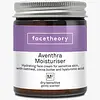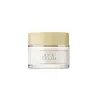What's inside
What's inside
 Key Ingredients
Key Ingredients

 Benefits
Benefits

 Concerns
Concerns

 Ingredients Side-by-side
Ingredients Side-by-side

Water
Skin ConditioningGlycerin
HumectantButyrospermum Parkii Butter
Skin ConditioningGlyceryl Stearate Se
EmulsifyingTheobroma Cacao Seed Butter
EmollientPrunus Amygdalus Dulcis Oil
Skin ConditioningOlea Europaea Fruit Oil
MaskingPropanediol
SolventCetyl Alcohol
EmollientStearic Acid
CleansingPanthenol
Skin ConditioningPrunus Armeniaca Kernel Oil
MaskingDalea Spinosa Seed Oil
MaskingOryza Sativa Bran Oil
EmollientTocopherol
AntioxidantAvena Sativa Kernel Flour
AbrasiveSodium Anisate
AntimicrobialSodium Levulinate
Skin ConditioningSodium Ascorbyl Phosphate
AntioxidantGlyceryl Caprylate
EmollientLactic Acid
BufferingSodium Hyaluronate
HumectantAmorphophallus Konjac Root Powder
AbrasiveCitrus Nobilis Peel Oil 0.485%
MaskingWater, Glycerin, Butyrospermum Parkii Butter, Glyceryl Stearate Se, Theobroma Cacao Seed Butter, Prunus Amygdalus Dulcis Oil, Olea Europaea Fruit Oil, Propanediol, Cetyl Alcohol, Stearic Acid, Panthenol, Prunus Armeniaca Kernel Oil, Dalea Spinosa Seed Oil, Oryza Sativa Bran Oil, Tocopherol, Avena Sativa Kernel Flour, Sodium Anisate, Sodium Levulinate, Sodium Ascorbyl Phosphate, Glyceryl Caprylate, Lactic Acid, Sodium Hyaluronate, Amorphophallus Konjac Root Powder, Citrus Nobilis Peel Oil 0.485%
Oryza Sativa Bran Water
MaskingWater
Skin ConditioningGlycerin
HumectantButylene Glycol
HumectantCetyl Ethylhexanoate
EmollientPentaerythrityl Tetraethylhexanoate
EmollientHydrogenated Polyisobutene
EmollientSynthetic Beeswax
Emulsion StabilisingButyrospermum Parkii Butter
Skin ConditioningPolyglyceryl-3 Methylglucose Distearate
EmulsifyingVinyldimethicone
Pentylene Glycol
Skin Conditioning1,2-Hexanediol
Skin ConditioningBehenyl Alcohol
EmollientGlyceryl Stearate
EmollientAmmonium Acryloyldimethyltaurate/Vp Copolymer
Bisabolol
MaskingCetearyl Olivate
Panthenol
Skin ConditioningSorbitan Olivate
EmulsifyingCaprylyl Glycol
EmollientEthylhexylglycerin
Skin ConditioningXanthan Gum
EmulsifyingAdenosine
Skin ConditioningTrisodium Ethylenediamine Disuccinate
Sodium Hyaluronate
HumectantCeramide NP
Skin ConditioningHydrolyzed Hyaluronic Acid
HumectantOryza Sativa Bran Oil
EmollientTocopherol
AntioxidantPhytosphingosine
Skin ConditioningCaprylic/Capric Triglyceride
MaskingHydrogenated Lecithin
EmulsifyingOryza Sativa Bran Water, Water, Glycerin, Butylene Glycol, Cetyl Ethylhexanoate, Pentaerythrityl Tetraethylhexanoate, Hydrogenated Polyisobutene, Synthetic Beeswax, Butyrospermum Parkii Butter, Polyglyceryl-3 Methylglucose Distearate, Vinyldimethicone, Pentylene Glycol, 1,2-Hexanediol, Behenyl Alcohol, Glyceryl Stearate, Ammonium Acryloyldimethyltaurate/Vp Copolymer, Bisabolol, Cetearyl Olivate, Panthenol, Sorbitan Olivate, Caprylyl Glycol, Ethylhexylglycerin, Xanthan Gum, Adenosine, Trisodium Ethylenediamine Disuccinate, Sodium Hyaluronate, Ceramide NP, Hydrolyzed Hyaluronic Acid, Oryza Sativa Bran Oil, Tocopherol, Phytosphingosine, Caprylic/Capric Triglyceride, Hydrogenated Lecithin
 Reviews
Reviews

Ingredients Explained
These ingredients are found in both products.
Ingredients higher up in an ingredient list are typically present in a larger amount.
This ingredient is also known as shea butter. It is an effective skin hydrator and emollient.
Emollients help soothe and soften your skin. It does this by creating a protective film on your skin. This barrier helps trap moisture and keeps your skin hydrated. Emollients may be effective at treating dry or itchy skin.
Shea butter is rich in antioxidants. Antioxidants help fight free-radicals, or molecules that may harm the body. It is also full of fatty acids including stearic acid and linoleic acid. These acids help replenish the skin and keep skin moisturized.
While Shea Butter has an SPF rating of about 3-4, it is not a sunscreen replacement.
Shea butter may not be fungal acne safe. We recommend speaking with a professional if you have any concerns.
Learn more about Butyrospermum Parkii ButterGlycerin is already naturally found in your skin. It helps moisturize and protect your skin.
A study from 2016 found glycerin to be more effective as a humectant than AHAs and hyaluronic acid.
As a humectant, it helps the skin stay hydrated by pulling moisture to your skin. The low molecular weight of glycerin allows it to pull moisture into the deeper layers of your skin.
Hydrated skin improves your skin barrier; Your skin barrier helps protect against irritants and bacteria.
Glycerin has also been found to have antimicrobial and antiviral properties. Due to these properties, glycerin is often used in wound and burn treatments.
In cosmetics, glycerin is usually derived from plants such as soybean or palm. However, it can also be sourced from animals, such as tallow or animal fat.
This ingredient is organic, colorless, odorless, and non-toxic.
Glycerin is the name for this ingredient in American English. British English uses Glycerol/Glycerine.
Learn more about GlycerinOryza Sativa Bran Oil comes from the outer layer of a rice kernel. It is a byproduct of milling rice, or the operation to produce a whole grain rice product.
This ingredient has emollient and skin conditioning properties. This is due to its polysaccharides and omega-3 fatty acids.
Emollients help soothe and soften the skin. It does this by creating a protective film on your skin. This barrier helps trap moisture and keeps your skin hydrated.
Learn more about Oryza Sativa Bran OilPanthenol is a common ingredient that helps hydrate and soothe the skin. It is found naturally in our skin and hair.
There are two forms of panthenol: D and L.
D-panthenol is also known as dexpanthenol. Most cosmetics use dexpanthenol or a mixture of D and L-panthenol.
Panthenol is famous due to its ability to go deeper into the skin's layers. Using this ingredient has numerous pros (and no cons):
Like hyaluronic acid, panthenol is a humectant. Humectants are able to bind and hold large amounts of water to keep skin hydrated.
This ingredient works well for wound healing. It works by increasing tissue in the wound and helps close open wounds.
Once oxidized, panthenol converts to pantothenic acid. Panthothenic acid is found in all living cells.
This ingredient is also referred to as pro-vitamin B5.
Learn more about PanthenolSodium Hyaluronate is hyaluronic acid's salt form. It is commonly derived from the sodium salt of hyaluronic acid.
Like hyaluronic acid, it is great at holding water and acts as a humectant. This makes it a great skin hydrating ingredient.
Sodium Hyaluronate is naturally occurring in our bodies and is mostly found in eye fluid and joints.
These are some other common types of Hyaluronic Acid:
Learn more about Sodium HyaluronateTocopherol (also known as Vitamin E) is a common antioxidant used to help protect the skin from free-radicals and strengthen the skin barrier. It's also fat soluble - this means our skin is great at absorbing it.
Vitamin E also helps keep your natural skin lipids healthy. Your lipid skin barrier naturally consists of lipids, ceramides, and fatty acids. Vitamin E offers extra protection for your skin’s lipid barrier, keeping your skin healthy and nourished.
Another benefit is a bit of UV protection. Vitamin E helps reduce the damage caused by UVB rays. (It should not replace your sunscreen). Combining it with Vitamin C can decrease sunburned cells and hyperpigmentation after UV exposure.
You might have noticed Vitamin E + C often paired together. This is because it is great at stabilizing Vitamin C. Using the two together helps increase the effectiveness of both ingredients.
There are often claims that Vitamin E can reduce/prevent scarring, but these claims haven't been confirmed by scientific research.
Learn more about TocopherolWater. It's the most common cosmetic ingredient of all. You'll usually see it at the top of ingredient lists, meaning that it makes up the largest part of the product.
So why is it so popular? Water most often acts as a solvent - this means that it helps dissolve other ingredients into the formulation.
You'll also recognize water as that liquid we all need to stay alive. If you see this, drink a glass of water. Stay hydrated!
Learn more about Water